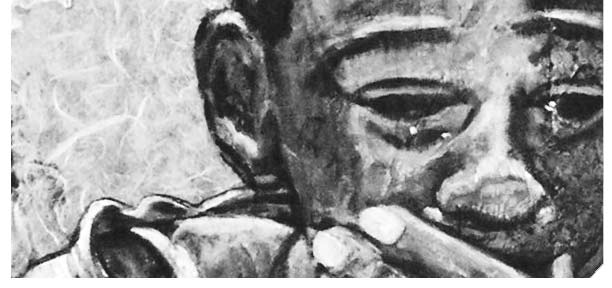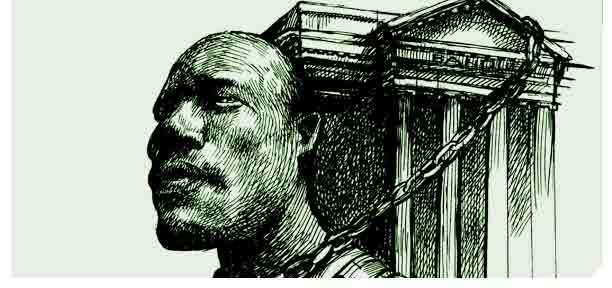Chicago artists donate work to benefit hurricane victims

by Robyn Coffey
Hopefully, there’s at least one art student out there who, upon viewing the news reports of the destruction left by Hurricane Katrina, said to himself, “Well, gosh. Me being an art student and all, I don’t have money to send to those poor victims. Wouldn’t it be great if I could sell my valuable artwork and donate the proceeds to New Orleans? ”
Chris Johnson, owner and curator of the Johnsonese Gallery in Bucktown, feels your pain. That’s why he’s organized a benefit called NOLA Aid — a group show of new and established Chicago artists whose work includes paintings, photographs, and collage. Johnson said he got the idea for a benefit from artist Mark Lockwood. “I thought it was a great idea,” explained Johnson, “because I work with emerging artists who probably don’t have the financial means to directly help with hurricane relief.”
Here’s how it works. The gallery is sending 50% of its profits directly to agencies and charities that are providing aid to Hurricane Katrina victims. The gallery is using 25% of the proceeds for promotion, rent, and utilities. If that’s less than direct cost, the extra will go toward disaster relief. Another quarter of the proceeds goes to the artists, who may choose to donate any part of it. So potentially, the benefit could send far more than 50% of the money to charities.
“I know that the proceeds for the exhibition will be miniscule compared to the donations of large companies and organizations,” said Lockwood. “But does that matter? I feel it’s our responsibility to use our gifts to help humanity.”
Buyers at the exhibition will get to choose from a list of charities compiled by Johnson and the artists, charities with specific importance to them, including the American Red Cross, the Chicago Helps Fund, the American Diabetes Association, and the American Humane Society. Johnson said he hopes that “people who purchase artwork during the benefit will be reminded of the cause when they see their art.”
It is clear that making this sort of impact by helping in the best way they can is important to the artists whose work was chosen for the show. Many of them had friends or family in the area affected by Katrina, or had lived in New Orleans themselves. Painter Sarah Hudgins is still missing two close friends and metalsmith Peter Gray estimates that officials have only located 70% of his family members. Hudgins recounted the time she spent there after graduating college, working as an assistant art director at Neal Auction House on Magazine Street.
“We drove endlessly through the bayou,” she remembered. “We ate blackened catfish, danced at Tipitina’s, and walked to Taqueria Corona with open bottles of beer.” Hudgins was on a trip in Houston when Katrina hit, and although she and her husband went to volunteer at the George R. Brown Convention Center, where people from flooded New Orleans were arriving on buses, eventually they had to go home. “The frustration of not being able to help more was thick,” she said. “I hate the feeling of being helpless to assist. I can’t build a house, send heaps of money, or host a TV show there. I needed something that I could do.”
Painter and SAIC alumna Laura Olear explained that “many artists aren’t able to make a monetary contribution, but have an excess inventory of art. In a sense, it’s like bartering the items that you have which are valuable — artwork — in exchange for something you want — to contribute to a charitable cause. ”
“I think the real potential for change,” adds photographer Stephanie Dean, “is not only in the purchase of art, but also in the making of art, and potentially art that addresses the political and social inadequecies of the situation.”
Johnson defines the gallery‘s focus as “progressive contemporary art. ” Not just any art, not just contemporary art, but art that is intended to lead the viewer’s gaze toward the larger picture. Progressive means forward-thinking, a bias toward improvement and change. Johnson feels that since the “traditional institutions” have failed at a proper response to the aftermath of the Katrina disaster, “NOLA Aid is a progressive response to this failure. We could sit back and complain, but instead we’re coming together to be a small part of the solution.”
Stefani Cole, a photographer who received her BFA from SAIC, agrees that the ideas and effort generated by the artists in the show will serve to inspire change. “It’s about artists using ideas to create change, or even just inspire the viewer to think about the world around them. It’s spurring thought by using whatever medium is necessary to the idea.”
Cole’s photographs in the exhibition directly address the emotion expressed by many victims of the hurricane. Her series entitled “Standing Still” is black and white landscapes, blurred as though one were speeding past them. Superimposed over them are drawings of a woman, who never meets the viewer’s eyes. “The pieces are about the times when we feel like the rest of the world is moving along so quickly, but we are struggling just to hold on,” said Cole. “My work is about how our environment affects our state of being, and we in turn affect the world around us.” The work of other artists in the show also reflect aspects of the situation in New Orleans. Olear’s mixed-media pieces are vividly-colored close-ups of microscopic Cryptosporidium cells, a bacteria that may be contaminating New Orlean’s water.
Peter Gray, who has a PhD in biomedicine and molecular biology, and who’s still missing family members, created two metal works entitled “Mom” and “Dad,” incised with the shapes of X and Y chromosomes.
An instructor in SAIC’s painting and drawing department, Elizabeth Tyson combines and deconstructs drawings, illustrations, and other media to create “hybrid organic images. ” Her piece for the show is called “Things Fall Together,” a product that came from the “process of dislocation as part of nature and as a manufactured or artificial nature,” she explained. “I thought the piece best represented the disclocation and fragmentation and chaos that I saw from images in the news and heard from accounts on the radio.”
But it’s self-taught artist and mother of three Kathy Halper’s mixed-media collage that gets you in the gut, and really hits home. It’s a picture of a woman covering her mouth, tears shining in her eyes, and shock and disbelief written on her face. Halper explains how she’d begun the collage while watching footage of Katrina’s damage. When she found the hurricane victim’s picture in the Tribune, Halper said there was something so “beautiful and tragic” about it that she used it instead of the original image she’d chosen.
“I had hoped to sell it and donate half the price to the Red Cross,” said Halper. “But Chris’ show came through and seemed the perfect venue for her to be seen. I call the piece ‘This is What it Looks Like to Lose Everything.’”
The woman’s heartbroken expression in the collage would be appropriate for one of Cole’s “Standing Still” photos — caught in a moment where time stops, even though the world is barreling down on you.
“Those moments are strange,” said Cole, “because for how difficult that time can be, if we pay attention to it, it is usually a defining moment that creates great change in our lives.” The opening reception for NOLA Aid is October 1, and the exhibition will be on view through November 5 at the Johnsonese Gallery, 2149 W. Armitage.
Artwork by Kathy Halper, image courtesy of the artist
October 2005






